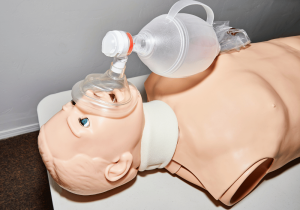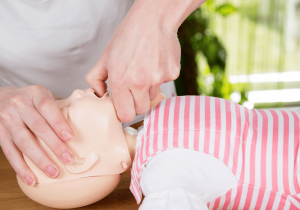
Menu
Close
Maintaining a clear and open airway is fundamental to saving lives in emergency situations. For first responders and healthcare workers, airway management is one of the most critical skills to master. Whether addressing a sudden airway obstruction, providing ventilatory support, or administering CPR, understanding the techniques and tools involved in airway training can make the difference between life and death. This guide outlines the essentials of airway training, including common practices, advanced tools, and the importance of developing confidence in high-pressure scenarios.
 Efficient airway management is a core competency for first responders and healthcare workers because of the life-threatening conditions associated with airway blockages. Issues such as cardiac arrest, trauma, anaphylaxis, or drug overdose often cause the airway to become obstructed. Without intervention, the resulting lack of oxygen can lead to brain damage or death in just minutes.
Efficient airway management is a core competency for first responders and healthcare workers because of the life-threatening conditions associated with airway blockages. Issues such as cardiac arrest, trauma, anaphylaxis, or drug overdose often cause the airway to become obstructed. Without intervention, the resulting lack of oxygen can lead to brain damage or death in just minutes.
For individuals operating in high-stakes environments, such as paramedics, nurses, and physicians in emergency settings, airway training offers the expertise needed to assess and manage respiratory distress effectively. Through proper training, they learn to recognize early signs of airway compromise like stridor, cyanosis, or diminished breath sounds, and respond appropriately.
Importantly, airway training doesn’t just teach procedures—it builds confidence. Fieldwork often requires split-second decisions, and rehearsing these techniques during training programs fosters the practical comfort required in emergencies. A well-trained individual becomes not only a responder but also a lifeline for patients experiencing critical conditions.
There is a range of life-saving techniques that form the foundation of airway management. Mastering these ensures professionals can handle a variety of emergencies with precision and care. One of the simplest yet most effective techniques to open a patient’s airway is the head-tilt, chin-lift maneuver. This method involves tilting the patient’s head back gently while lifting the chin upward to prevent the tongue from blocking the airway. It’s particularly useful for unconscious patients who are experiencing airway obstruction without significant risk of spinal trauma.
For patients with suspected neck injuries, the jaw thrust technique is the safer alternative. Instead of tilting the patient’s head, rescuers manipulate the jaw directly to open the airway, thereby minimizing movement of the neck and reducing the chance of exacerbating potential spinal injuries.
Airway training also covers the removal of obstructions such as vomit, blood, or mucus using manual suction devices. Clearing these blockages ensures that airflow to the lungs remains unobstructed. Proper training ensures that suction devices are used effectively without risking damage to sensitive tissues in the mouth or throat. Combining these basic techniques with situational awareness prepares responders to address a majority of airway emergencies confidently.
From basic equipment to more advanced devices, proper use of airway management tools is crucial in delivering effective care. Training programs provide hands-on experience with this equipment to ensure proficiency across different scenarios. Bag-valve masks are a staple tool in emergency airway management. These devices provide manual ventilation and are essential for patients in respiratory distress who are unable to breathe effectively on their own. Proper training teaches how to achieve an adequate seal over the patient’s face while coordinating manual compressions of the bag to deliver oxygen.
Trainees learn the importance of using the appropriate size mask and delivering each ventilation over one second to simulate normal breathing and avoid complications like gastric inflation. Whether in a prehospital or clinical setting, competency in using a BVM is non-negotiable for any first responder.
For cases where basic methods are insufficient, advanced airway devices like endotracheal tubes (ETTs) or supraglottic airways provide reliable alternatives. Endotracheal intubation, for example, involves the insertion of a tube into the patient’s trachea to guarantee a secure and unobstructed airway. Training programs often use mannequins or simulation aids to allow trainees to practice the critical skills and spatial awareness needed for successful insertion. Similarly, supraglottic airways, such as laryngeal mask airways (LMAs), are simpler to use and offer an effective option for patients who cannot be intubated immediately. Familiarizing oneself with these tools ensures that responders have adaptable solutions when basic interventions are insufficient.
 Managing airways in pediatric patients requires specialized knowledge due to their unique anatomical structures. Compared to adults, children have smaller and more easily obstructed airways and differ in everything from tongue size to cartilage flexibility. These differences highlight the need for targeted training in managing pediatric respiratory emergencies.
Managing airways in pediatric patients requires specialized knowledge due to their unique anatomical structures. Compared to adults, children have smaller and more easily obstructed airways and differ in everything from tongue size to cartilage flexibility. These differences highlight the need for targeted training in managing pediatric respiratory emergencies.
For example, using the head-tilt, chin-lift technique in children must be done more cautiously to avoid excessive pressure that might compress the soft tissues of their airway. Similarly, pediatric bag-valve masks and airway adjuncts come in smaller sizes, requiring precision in their application.
Airway training also emphasizes recognizing early signs of airway obstruction in children, such as high-pitched wheezing or abnormal posture like tilting the head forward. These subtle indicators allow first responders to act appropriately before the situation worsens. Ultimately, training programs equip medical professionals with skills tailored to the specific needs of pediatric patients.
Airway training involves more than just theory. Successful programs leverage realistic simulations to provide hands-on practice in diverse scenarios, helping responders prepare for the dynamic nature of medical emergencies.
Through simulation exercises, participants can practice high-pressure decision-making in controlled environments. Scenarios might include using an advanced airway in a cardiac arrest patient or managing a multi-trauma situation where spinal precautions are mandatory. These exercises also explore troubleshooting unexpected complications, such as recognizing airway misplacement during intubation and promptly correcting it.
Simulation-based learning reinforces teamwork as well. Emergency airway management often requires cooperation between multiple responders, making effective communication and a clear division of roles vital. Trainees learn how to execute their responsibilities seamlessly alongside others, further improving outcomes during real-life situations.
Like any clinical skill, airway management requires continuous practice to stay sharp. Techniques evolve as medical advancements bring new tools and guidelines. For first responders and healthcare professionals, staying current on training ensures their methods align with the latest standards of care.
Ongoing education also enhances confidence. Even experienced professionals benefit from regularly practicing airway interventions in simulated environments to prevent skills from becoming rusty. Refresher courses and advanced certifications provide opportunities for growth, helping individuals take on more complex responsibilities in patient care. Investing in regular airway training isn’t optional—it’s the foundation for delivering fast, effective intervention in critical moments.
Airway training is a vital skill set for first responders and healthcare workers who operate in high-pressure environments. Whether clearing obstructed airways through basic techniques, applying advanced airway tools, or navigating pediatric challenges, proficiency in these practices can dramatically improve patient outcomes. For those committed to making a difference in emergency medicine, mastering airway management through rigorous, hands-on training is an essential step. CPR Depot Canada offers comprehensive airway training products tailored to suit the needs of medical professionals. Equip yourself with the tools that save lives—explore airway training supplies at CPR Depot Canada today.